Dravida Style of Architecture is one of the types of Temple architecture. It is an important segment of the Art & Culture syllabus of the IAS Exam. This article will provide you with the Dravida Style of Architecture that originated during the reign of Mahendravarman-I of Pallava Dynasty.
| To complement your preparation for UPSC 2023, check the following links: |
Temple Architecture in India-Part III (UPSC Notes):- Download PDF Here
Dravidian Style of Architecture – South Indian Style
The features of the Dravidian Style of Architecture are mentioned below:

- The temple is enclosed within a compound wall.
- Gopuram: The entrance gateway in the centre of the front wall.
- Vimana: The shape of the main temple tower. It is a stepped pyramid that rises up geometrically (unlike the Nagara style Shikhara that is curving).
- In the Dravida style, shikhara is the word used for the crowning element at the top of the temple (which is shaped like a stupika or octagonal cupola).
- At the entrance to the garbhagriha, there would be sculptures of fierce dvarapalas guarding the temple.
- Generally, there is a temple tank within the compound.
- Subsidiary shrines could be found wither within the main tower or beside the main tower.
- In many temples, the garbhagriha is located in the smallest tower. It is also the oldest. With the passage of time and the rise of the population of the temple-town, additional boundary walls were added. The newest structure would mostly have the tallest gopuram.
- Example in the Sriranganathar Temple at Srirangam, Tiruchirappally, there are 7 concentric rectangular enclosure walls each having gopurams. The tower at the centre has the garbhagriha.
- Famous temple towns of Tamil Nadu: Kanchipuram, Thanjavur (Tanjore), Madurai and Kumbakonam.
- In the 8th to 12th centuries – temples were not confined to being religious centres but became administrative centres as well with large swathes of land.
Dravidian Architecture – Subdivisions of Dravida Style
- Kuta or Caturasra: square-shaped
- Shala or Ayatasra: rectangular-shaped
- Gaja-prishta or vrittayata or elephant-backed: elliptical
- Vritta: circular
- Ashtasra: octagonal
Pallava Architecture
- The Pallava dynasty was ruling in the Andhra region from the 2nd century AD onwards. They then moved southwards to Tamil Nadu.
- They built many monuments and temples during the 6th to the 8th centuries.
- Although they were mostly Shaivite, some Vaishnava monuments are also seen. Their architecture was also influenced by the Buddhist heritage of the Deccan.
- Their early buildings were rock-cut whereas the later were structural.
- The early buildings were built during the reign of Mahendravarman I, a contemporary of the Chalukya king Pulakeshin II of Karnataka.
- His son Narasimhavarman I, also known as Mamalla, was a great patron of the arts. Most buildings in Mahabalipuram (also called Mamallapuram in his honour) are attributed to him.
- In Mahabalipuram, there are exquisite monolithic rathas and mandapas. The five rathas are known as Panchapandava Rathas.
Dravidian Temple Architecture – Shore Temple – Mahabalipuram
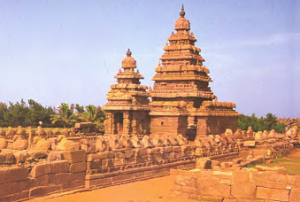
- Built during the reign of Pallava king Narasimhavarman II, also known as Rajasimha (700 – 728 AD).
- It has three shrines – one Shiva shrine facing east, one Shiva shrine facing west, a middle shrine to Vishnu in Anantashayana pose. The presence of three main shrines is unique.
- It is probable that the shrines were not all built at the same time but were added later.
- There is evidence of a water reservoir and a gopuram.
- There are sculptures of Nandi the bull (Shiva’s mount) along the walls of the temple. There are several carvings as well.
Dravidian Temple Architecture – Brihadiswara Temple – Tanjore
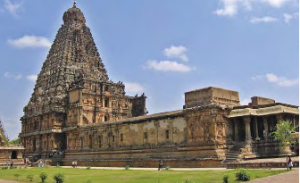
- Shiva temple, also called Rajarajeswara Temple.
- Completed around 1009 AD. Built by Rajaraja Chola.
- It is the largest and tallest of all Indian temples. This Chola temple is bigger than any of the previous Pallava, Chalukya or Pandya structures.
- More than 100 temples of the Chola Period are preserved. A lot of temples were constructed during the Chola period.
- Its pyramidal multi-storied vimana is almost 70 metres high.
- There is a monolithic shikhara atop the vimana.
- The shikhara is a dome-shaped octagonal stupika. It has two large elaborately sculptured gopuras. On the shikhara, there are large Nandi images.
- The kalasha on top of the shikhara is 3m and 8cm tall.
- There are hundreds of stucco figures on the vimana. Many might have been added later on in the Maratha period.
- The main deity of Shiva is portrayed as a huge lingam set in a double-storied sanctum.
- The surrounding walls of the sanctum are adorned with painted murals and sculptures of mythological stories.
Architecture in the Deccan
- A hybridised style mixing elements from both Nagara and Dravida styles emerge as a distinct style during the middle of the 7th century in regions like Karnataka.
- This is referred to as Vesara in some ancient texts.
- Some of the temples are either completely nagara or dravida. Not all temples in the Deccan are in vesara style.
- Kailashnath Temple, Ellora

- Completely in Dravida style.
- Main deity is Lord Shiva.
- There is also a Nandi shrine.
- Vimana rises 30 m.
- This temple was carved out of a portion of a hill.
- The temple is grand and imposing.
- Built during the Rashtrakuta phase at Ellora.
Chalukya Architecture
- Western Chalukya kingdom was established by Pulakesin I when he took control of the land around Badami in 543 AD.
- Early western Chalukyas ruled the region till around the mid-8th century.
- Early activities are rock-cut caves while structural temples were built later on.
- Ravana Phadi cave at Aihole
- Important structure at this site: Nataraja
- This image is surrounded on the right by four large saptamatrikas and on the left by three large ones.
- The figures have slim, graceful bodies. They have long oval faces. They wear short pleated dhotis and tall cylindrical crowns.
- Distinct feature of Chalukya architecture: mixing and incorporation of several styles.
- Temples at Pattadakkal, Karnataka
- Pattadakkal is a UNESCO World Heritage Site.
- There are 10 temples. Four are in Dravida style, four are in Nagara style, one (Papanatha Temple) is a fusion of both and one is a Jain temple.
- Jain Narayana temple – built by Rashtrakutas in the 9th century.
- Virupaksha Temple – built by the chief queen of Chalukya king Vikramaditya II (733 – 44), Loka Mahadevi. Best example of Dravida style.
- Durga Temple, Aihole
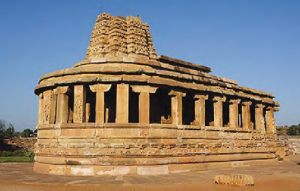
- Apsidal shrine resembling a Buddhist Chaitya hall.
- Surrounded by a veranda.
- Shikhara is like a nagara one.
- The Lad Khan temple at Aihole
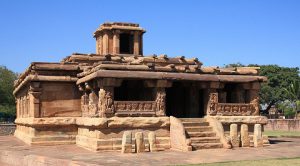
- Located south of the Durga temple. Built in the 5th century.
- Inspired by the wooden-roofed temples of the hills, but is made out of stone.
- Built in the Panchayatana style.
- So named because a person named Lad Khan had used it as his residence for some time.
Hoysalas Temple Architecture
- Hoysalas grew into prominence in South India after the Chola and the Pandya power declined.
- Centred at Mysore.
- Chief temples are at Belur, Somnathapuram and Halebidu.
- These temples have a plan called the stellate plan. This is because the plan which emerged from being a straightforward square to a complex one with many projecting angles began to resemble a star.
- The star-like ground plan is a distinct feature of Hoysala architecture.
- Style is Vesara.
- Made of soapstone which is relatively soft. This enabled artists to carve intricate details like jewellery.
- Hoysaleshvara Temple, Halebid
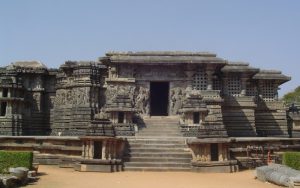
- Made of dark schist stone in 1150.
- Dedicated to Nataraja (Shiva).
- It is a double building with a large hall for the mandapa.
- A Nandi pavilion is in front of each building.
- The temple’s tower fell a long time back. The structure of the temple is evident from the detailed miniature ones at the temple’s entrance.
- Very intricate and detailed carvings.
Vijayanagara Architecture
- City of Vijayanagara (City of victory) founded in 1336.
- Visited by international travellers like Niccolo di Conti, Domingo Paes, Duarte Barbosa, Abd, al-Razzaq, etc. who have given vivid accounts of the place.
- Synthesizes the Dravida style with Islamic styles of the neighbouring sultanates.
- The sculpture tries to recreate the Chola tradition but the foreign influence is also seen.
Temple Architecture in India-Part III (UPSC Notes):- Download PDF Here
This chapter is continued in the link given below:
NCERT Notes: Temple Architecture and Sculpture – Part IV
Also see other NCERT notes:
| Post-Mauryan Trends in Indian Art and Architecture – Part I |
| Post-Mauryan Trends in Indian Art and Architecture – Part II |
| Post-Mauryan Trends in Indian Art and Architecture – Part III |
UPSC Books List PDF:-Download PDF Here
UPSC Preparation:
| UPSC Prelims | UPSC Mains |
| UPSC Exam Pattern | IAS Current Affairs |
| UPSC Books | Daily Video Analysis: The Hindu |
| India Year Book – 5 Things to Know | UPSC Admit Card |
Comments